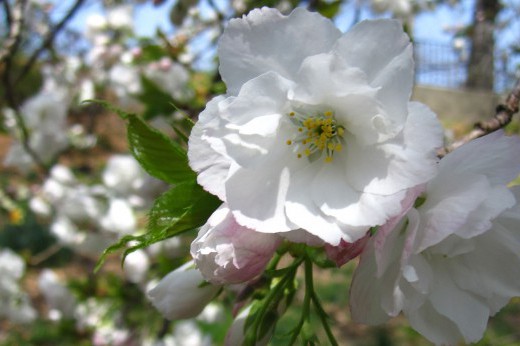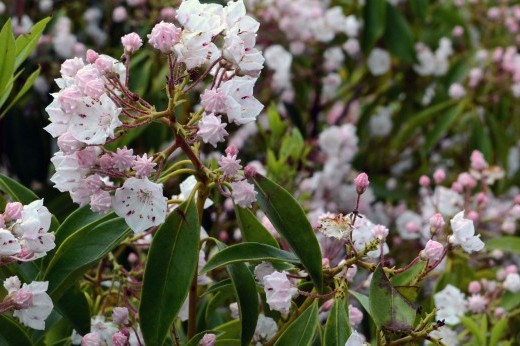As cooperative extension specialists and researchers based in Ohio, we're often asked to recommend small (under 25 feet), low-maintenance trees that provide landscape interest for three or four seasons. Our advice is always unanimous: crabapples! Among the showiest of spring bloomers, crabapples are also wonderful foliage plants in summer and fall, and they provide beautiful fruit displays late in the season. Furthermore, they come in a range of sizes and forms, many of which create interesting silhouettes in the winter landscape.
Known also as crab trees, crabs, wild apples, and schoolboy apples, crabapples belong to the Rosaceae, or rose family. They share the same genus—Malus—as apples. All apples, including crabapples, are believed to have originated in the mountains of Kazakhstan. Though it's not clear how they arrived here, at least three crabapple species are native to North America: Malus coronaria, M. fusca, and M. ioensis. Most of our other crabapple species, native to Europe and Asia, prospered when brought here as seeds or cuttings by colonists.
To a crabby few, it's still a matter of unscientific contention that apples and crabapples reside in the same genus. But the difference is arbitrary. It's a rare instance in which size does matter: A Malus tree with fruit that's two inches or more in diameter is considered an apple, while a Malus tree with fruit smaller than two inches is considered a crab. That's it. All crabapple fruits are technically edible, though (as their common name suggests) most are bitter tasting. Perhaps the best description of that special "crabbed" flavor comes from Henry David Thoreau's essay "Wild Apples": "sour enough to set a squirrel's teeth on edge and make a jay scream."
More: Learn how to plant mountain laurel, a native shrub with gorgeous flowers, in your garden or backyard.
The quest of early apple planting in America wasn't to obtain an apple for eating, but rather an apple for drinking—cider, that is. It led to a massive but totally random hybridization effort that resulted in many fruits that were bitter and acrid. Fruits too sour to eat were known as "spitters," but it was soon discovered that certain fermented combinations of these (many of them crabs) and sweeter apples made an excellent beverage.
Crabapples have other uses too, of course. They often contain high amounts of pectin, which helps to firm up jellies, jams, and apple butter. They are also valuable to wildlife. Birds, especially cedar waxwings, often attack crabapple fruits with gusto as the crop softens and ages with successive freezes in the fall.
True to their rugged, mountainous origin, crabapples are tough and adaptable, and they can thrive in many different climates and environments. The trees need well-drained soils and tolerate pH ranges from 5.0 to 7.5, though they prefer it slightly acidic (6.2–6.8). Most are hardy from USDA Zones 4 to 7 and should be planted in full sun to maximize flower and fruit development. When propagated in containers or raised as ball-and-burlap nursery stock, crabapples may be planted anytime. If purchased as bare-root plants, however, crabapples should be planted in early spring, before they begin to leaf out.
After they become established, crabapples require minimal care. Most of the maintenance involves elimination of branches that cross over or rub against others, as well as the removal of water sprouts, suckers, and branches that grow too vigorously (four to eight feet per season). Crabapple species and cultivars have historically been susceptible to a wide range of diseases, especially apple scab fungus, cedar-apple rust, and fire blight. Many modern cultivars possess superior resistance to these diseases.
Following are ten highly recommended crabapples chosen from the Crablandia II research plot at Ohio State University's Secrest Arboretum, in Wooster, Ohio. They are among 68 crabapple cultivars (most of them planted in 1998) currently being evaluated at the plot for their disease susceptibility and general aesthetics. We chose these ten trees based on their impressive bloom and fruit, and the fact that they are unaffected by apple scab. Our vigorous discussions about which plants to include (there are so many great crabapples!) sometimes ended peacefully, but often they were terminated by a good old-fashioned crabapple fight.
Malus 'Adirondack'
Attributes: This is a pleasing, narrow, strongly upright tree with medium-green leaves. Profuse, showy white flowers emerge from rose-pink buds and line its branches in spring. The plant's oblong, half-inch-wide, deep orange-red fruits are impressive from late August through mid-December.
Drawbacks: 'Adirondack' is somewhat slow to establish; leafhoppers appear to relish the foliage but do little damage.
Malus 'Excalibur'
Attributes: This globe-shaped dwarf crabapple grows up to eight feet tall. Petite white flowers line its branches in spring. Tiny, glossy, golden-yellow fruits develop and are outstanding from mid-September to mid-December. They mature to a pleasing shiny, cider-brown color. When lined with fruit, this tree creates a striking statement in the landscape.
Drawbacks: The flowers may be hidden by rapidly expanding foliage, and the fruits are hidden within the plant interior until leaves drop. Apple mosaic virus was noted on it in the Crablandia II plot.
Malus 'Firebird'
Attributes: Tiny white flowers accent this upright, vase-shaped tree in spring. Very small, red-orange fruits are dispersed along the branches from late September to early January. Due to top grafting, this tree maintains its unique form, so it's perfect for size-restricted spaces. (If it's unavailable, try another fabulous top-grafted red-fruited crabapple called 'Lollipop'.)
Drawbacks: 'Firebird' is slow to establish and grow. The flower and fruit displays are steady but scattered and never dazzling.
Malus 'Hozam' Holiday Gold
Attributes: This rounded, open-form tree produces clusters of impressive fragrant white blooms year in and year out. It's one of the best of the new yellow-fruited crabapples. Lasting from late August to late January, the fruit mellows from an attractive cream-yellow to a deep gold-yellow and can develop a nice rose blush in exposed sites. (If it's unavailable, try another great yellow-gold fruited crabapple named 'Bob White'.)
Drawbacks: The tree's form can become awkward due to repeated fruit loads, and a trace of fire blight was noted in the plot.
Malus 'Louisa'
Attributes: Gorgeous, true pink flowers enhance the classical weeping form of this crabapple in spring. It's one of the best weepers, with arching, graceful branches that are upswept at the tips. Scattered lemon-gold fruits are noticeable from late July to mid-November. They darken to gold-orange with a tan-brown blush.
Drawbacks: Fruit set is light and scattered.
Malus baccata 'Jackii' (Siberian crabapple)
Attributes: Lightly scented white flowers accent this large, fast-growing, broadly rounded tree. The large, glossy green leaves are by far the best of any crabapple in the plot. Maroon-red fruits color up by late July and last until mid-December. The contrast between the red fruits and the fall yellow-and-rust-colored leaves is outstanding. Frost can cause the bark of the tree to take on an orange cast.
Drawbacks: The fruit set is relatively sparse, so 'Jackii' has a fairly mediocre winter appearance.
Malus sargentii 'Tina'
Attributes: Creamy-white flowers densely pack this dwarf (five-foot), mounded, spreading crabapple in spring. They arise from diminutive pink buds and almost encircle the tree's branches. Petite red-purple fruits provide color from early August and drop rapidly in late November. Its miniature form and dainty twigs and foliage give this tree a bonsai-like quality.
Drawbacks: 'Tina' is a very slow grower, and it requires annual pruning.
Malus 'Prairifire'
Attributes: Striking coral-red flowers seem to fill up the rounded, open form of this tree in spring. The blooms contrast well with emerging, red-tinged green foliage. Purple-red fruits are immediately noticeable in late June and hang until early December. They age slowly to a cherry red. The tree has an attractive speckled bark.
Drawbacks: This cultivar has a mediocre winter and early-summer appearance. It has also shown traces of scab for the past three years in the test plot.
Malus 'Red Jewel'
Attributes: This upright, open tree is decked with very attractive snow-white flowers in spring. Sparkling, phenomenally firm, cherry-red fruits adorn it in early September and remain impressive into mid-April.
Drawbacks: 'Red Jewel' has a mediocre late-winter to early-spring appearance. It is slow growing and a bit awkward looking. In the test plot, it had a trace of scab, but just in 2000, along with some fire blight problems.
Malus 'Royal Raindrops'
Attributes: One of the best new cultivars, 'Royal Raindrops' is a broadly rounded tree with vibrant and abundant burgundy-red spring flowers. Red-purple fruit appear in mid-July and remain firm until early October. The tree has beautiful, cut-leaf foliage. New leaves are wine red in color and mature to green with burgundy overtones and eventually turn orange-red in fall.
Drawbacks: The flowers can get lost amid emerging foliage; the fruit only becomes noticeable late in the growing season.
Nursery Sources:
Allisonville Nursery11405 Allisonville Road
Fishers, IN 46038
317-849-4490
www.allisonvillenursery.com
Forestfarm
990 Tetherow Road
Williams, OR 97544-9599
541-846-7269
www.forestfarm.com
McKay Nursery Co.
P.O. Box 185
Waterloo, WI 53594
800-236-4242
www.mckaynursery.com
Twombly Nursery
163 Barn Hill Road
Monroe, CT 06468
203-261-2133
www.twomblynursery.com



